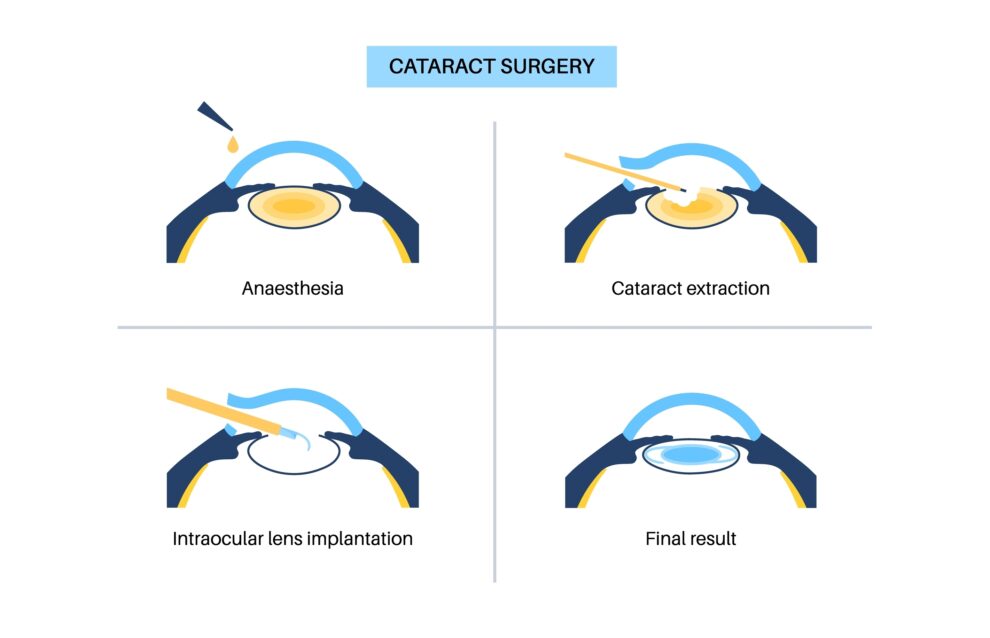Posted by: Albany Cornea | Center For Eye Care Excellence in Cataract Surgery

Living with cataracts that interfere with daily activities like reading, driving, or recognizing faces? You may be ready to consider cataract surgery.
Laser cataract surgery offers a customized treatment approach that can deliver exceptional visual results. This advanced technique allows your surgeon to create a precise, personalized procedure tailored to your specific needs.
Let’s explore what actually happens during laser cataract surgery and what you can expect from this innovative procedure!
What are Cataracts?

A cataract is the clouding of the natural lens of the eye. It occurs when proteins inside the lens break down and clump, forming a cloudy area.
For most people, cataracts usually don’t cause any symptoms in their early stages. However, as they progress and cloud more of your lens, you may experience symptoms such as:
- Blurred or cloudy vision
- Seeing halos around lights
- Difficulty seeing at night
- Sensitivity to glare and light
- Yellowing or fading of colors
- Double vision in one eye
- Requiring brighter lighting for up-close activities
When these symptoms make it challenging to see and perform regular activities, your ophthalmologist may recommend cataract surgery. Cataract surgery is the only effective treatment for cataracts.
There are two main types of cataract surgery: traditional and laser cataract surgery.
What Happens During Traditional Cataract Surgery?
In traditional cataract surgery, your cataract surgeon begins by numbing your eye with anesthetic drops to ensure the entire procedure is comfortable.
Next, they create a tiny incision in your cornea by hand with a blade or scalpel. They then insert another instrument to create an opening in the capsule that holds your eye’s natural lens affected by the cataract.

Your surgeon will insert a probe that applies ultrasound waves to break up the cloudy lens into tiny pieces. All the fragments are then suctioned out.
Once complete, your surgeon will insert a new intraocular lens (IOL) to replace your eye’s natural lens, which will restore clear vision. The incision is self-healing and typically doesn’t require sutures.
What Happens During Laser Cataract Surgery?
Laser cataract surgery leverages advanced technology to enhance the procedure. It replaces several manual steps of traditional cataract surgery with a precision femtosecond laser.
Before your procedure, your surgeon uses the femtosecond laser system to map your eye’s surface and collect detailed information about the cataract-affected lens. This data is processed by a computer that programs the laser with precise measurements for incision depth, size, and location.
During the procedure, your surgeon:
- Applies numbing eye drops to prevent any discomfort
- Uses the programmed laser to make precise incisions in your cornea and lens capsule
- Softens the cataract with laser energy
- Uses an ultrasound probe to break the softened lens into fragments and remove them
- Places your new IOL in the capsular bag that previously held your natural lens
- If needed, creates precise relaxing incisions to minimize astigmatism
What is Recovery Like After Laser Cataract Surgery?

After your procedure, your surgeon places a protective shield over your eye and monitors you briefly in a recovery area.
Before discharge, you’ll receive:
- Prescription antibiotics and anti-inflammatory eye drops
- Detailed post-operative care instructions
- A schedule for follow-up appointments
It’s crucial to apply eye drops as directed and follow all guidelines for successful recovery. Attending all follow-up visits allows your surgeon to monitor healing and address any potential issues early.
While some patients experience clear vision almost immediately, you may have blurred vision for about two days post-procedure. For others, vision may take 2-3 weeks to fully stabilize.
You’ll need to avoid strenuous activities for 1-2 weeks and refrain from driving for a few days until your ophthalmologist clears you to resume these activities.
What are the Benefits of Laser Cataract Surgery?
Here’s what sets laser cataract surgery apart:
Increased Precision and Efficiency
The femtosecond laser system provides exceptional accuracy, allowing your surgeon to make precise incisions that reduce potential human error and produce the best results.
Perfect Lens Capsule Opening
The laser creates perfectly circular and centered openings in the lens capsule that even the most skilled surgeon can’t match by hand. This precision allows for proper IOL positioning for enhanced vision correction.
Enhanced Lens Softening
By pre-softening the cataract with laser energy, less ultrasound power is required to break it up. This reduced ultrasound exposure decreases the risk of corneal swelling after surgery, leading to clearer vision sooner.
Bladeless Corneal Incisions
The laser creates precise corneal incisions with perfect architecture and placement, eliminating the need for metal blades or scalpels. These laser-created incisions typically heal more predictably than manual incisions.
Astigmatism Correction
The laser can create precise, relaxing incisions in the cornea to help minimize astigmatism, a common vision problem.
Together, these five advanced features provide the highest probability of reducing your need for glasses for both distance and near vision after surgery.
Say Goodbye to Cataracts with Laser Cataract Surgery

At Center For Eye Care Excellence, we’re proud to offer laser cataract surgery, the most advanced technology in cataract extraction. Laser cataract surgery is more accurate and precise than previously possible, ensuring the best possible outcomes for our patients.
With its ability to create bladeless incisions, perfectly center the lens implant, and potentially reduce astigmatism, our laser cataract surgery offers the highest probability of reducing your need for glasses for both distance and near vision.
Are you interested in laser cataract surgery? Schedule your appointment at Center for Eye Care Excellence in Albany, NY, today to get on the path to clearer vision with less dependence on corrective eyewear.

